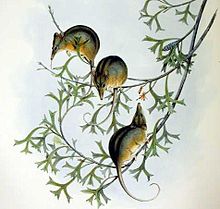- Honey possum
-
honey possum[1] 
Conservation status Scientific classification Kingdom: Animalia Phylum: Chordata Class: Mammalia Infraclass: Marsupialia Order: Diprotodontia Family: Tarsipedidae
Gervais & Verreaux, 1842Genus: Tarsipes
Gervais & Verreaux, 1842Species: T. rostratus Binomial name Tarsipes rostratus
Gervais & Verreaux, 1842
Honey Possum range The honey possum (Tarsipes rostratus) or tait, its Native Australian name[3] or noolbenger is a tiny Australian marsupial weighing just seven to eleven grams for the male, and eight to sixteen grams for the female—about half the weight of a mouse. Their physical size ranges from a body length of between 6.5 – 9 cm. They have a typical lifespan of between one and two years.[4]
The honey possum has no close relatives. It is currently classified as the only member of the genus Tarsipes and of the family Tarsipedidae, but many authorities[who?] believe that it is sufficiently distinct to be more properly raised to a separate superfamily within the Diprotodontia, or perhaps even further. It is thought to be the sole survivor of an otherwise long-extinct marsupial group. Although restricted to a fairly small range in the southwest of Western Australia, it is locally common and does not seem to be threatened with extinction so long as its habitat of heath, shrubland and woodland[4] remains intact and diverse.
It is one of the very few entirely nectarivorous mammals; it has a long, pointed snout and a long, protusible tongue with a brush tip that gathers pollen and nectar, like a honeyeater or a hummingbird. Its teeth are fewer and smaller than is typical for marsupials, with the molars reduced to tiny cones, and a dental formula of
Dentition 2.1.1.3 1.0.0.3 Floral diversity is particularly important for the honey possum as it cannot survive without a year-round supply of nectar, and unlike nectarivorous birds, it cannot easily travel long distances in search of fresh supplies. Radio-tracking has shown, however, that males particularly are quite mobile, moving distances of up to 0.5 km in a night and with utilisation areas averaging 0.8 hectares.[5] Both its front and back feet are adept at grasping, enabling them to climb trees with ease, as well as traverse the undergrowth at speed. Honey possums can also utilise their tail (which is longer than their head and body combined) to grip, much like another arm.[4]
The honey possum is mainly nocturnal but will come out to feed during daylight in cooler weather. Generally, though, it spends the days asleep in a shelter of convenience: a rock cranny, a tree cavity, the hollow inside of a grass tree, or an abandoned bird nest. When food is scarce or in cold weather, it becomes torpid to conserve energy.
Reproduction
Breeding depends on the availability of nectar and can occur at any time of the year. Females are promiscuous, mating with a large number of males. Competition has led to the males having the largest testes relative to their body weight for any known mammal, being 4.2 per cent. Their sperm is also the largest in the mammal world, measuring 0.36mm. Gestation lasts for 28 days, 2-3-4 young being produced. At birth they are the smallest of any mammal, weighing 0.005g.[citation needed] Nurturing and development within the pouch lasts for about 60 days, after which they emerge covered in fur and with open eyes, weighing some 2.5g. As soon as they emerge, they are often left in a sheltered area (such as a hollow in a tree) while the mother searches for food for herself, but within days they learn to grab hold of the mother's back and travel with her. However, their weight soon becomes too much, and they will stop feeding off milk at around eleven weeks, and start to make their own homes shortly after this.[4] As is common in marsupials, a second litter is often born when the pouch is vacated by the first, fertilised embryos being stopped from developing - see diapause. [6]
Most of the time, honey possums will stick to separate territories of about one hectare (2.5 acres),[7] outside of the breeding season. They live in small groups of no more than ten, which results in them engaging in combat with one another only rarely. During the breeding season, females will move into smaller areas with their young, which they will defend fiercely, especially from any males.[4]
References
- ^ Groves, C. (2005). Wilson, D. E., & Reeder, D. M, eds. ed. Mammal Species of the World (3rd ed.). Baltimore: Johns Hopkins University Press. pp. 55-56. OCLC 62265494. ISBN 0-801-88221-4. http://www.bucknell.edu/msw3.
- ^ Friend, T., Morris, K., Burbidge, A. & McKenzie, N. (2008). Tarsipes rostratus. In: IUCN 2008. IUCN Red List of Threatened Species. Downloaded on 28 December 2008. Database entry includes justification for why this species is of least concern
- ^ Chambers English Dictionary
- ^ a b c d e Branson, Andrew; Martyn Bramwell, Robin Kerrod, Christopher O'Toole, Steve Parker, John Stidworthy (1993). The Illustrated Encyclopedia of Mammals. Andromeda Oxford. pp. 26–27. ISBN 1-871869-16-1.
- ^ BRADSHAW, S. D. & BRADSHAW, F. J. (2002) Short-term movements and habitat utilisation of the marsupial Honey possum, Tarsipes rostratus. Journal of Zoology (London) 258, 343-348.
- ^ http://www.bbc.co.uk/nature/wildfacts/factfiles/655.shtml
- ^ Russell, Eleanor M. (1984). Macdonald, D.. ed. The Encyclopedia of Mammals. New York: Facts on File. pp. 878–879. ISBN 0-87196-871-1.
Categories:- IUCN Red List least concern species
- Possums
- Mammals of Western Australia
- Monotypic mammal genera
Wikimedia Foundation. 2010.

